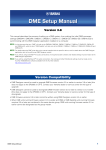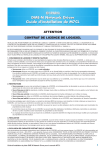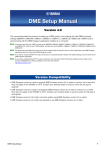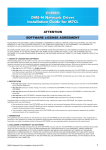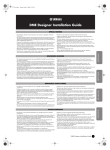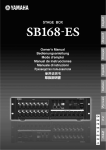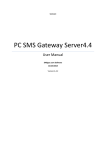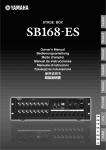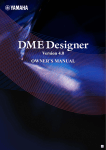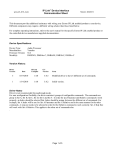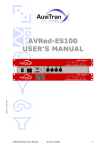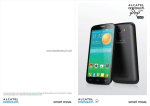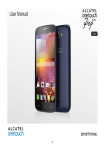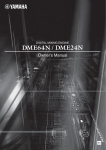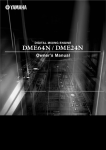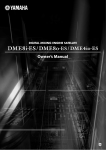Download Yamaha DME Musical Instrument User Manual
Transcript
DME Setup Manual Workflow This manual describes the process of setting up a DME system, from making the initial DME processor settings (DME64N / DME24N / DME8i-C / DME8o-C / DME4io-C / DME8i-ES / DME8o-ES / DME4io-ES) to synchronizing with the DME Designer application installed on a computer. n For details about the DME units refer to the manual supplied with the specific device, and for details about the DME Designer application refer to the pdf-format DME Designer manual. n In this document the term “DME” will refer to the DME64N, DME24N, DME8i-C, DME8o-C, DME4io-C, DME8i-ES, DME8o-ES and DME4io-ES, while the term “DME Satellite” will refer only to the DME8i-C, DME8o-C, DME4io-C, DME8i-ES, DME8o-ES and DME4io-ES. Software Installation ● DME Designer and DME-N Network Driver installation (page 3). ● USB-MIDI Driver installation (page 4). DME Network Setup (page 6) Connecting via a USB cable and setting the DME IP address and Device Group Master/Slave status from the DME Designer. Computer to DME Connection (page 8) The procedures for connecting a single DME unit to a computer as well as for connecting multiple DME units to a computer in the same subnet are described. Refer to the DME manual for information on audio connection and further network connection details. Computer Network Setup These settings must be made properly when connecting a computer to DME units via an Ethernet cable. ● Computer TCP/IP settings (page 9). ● DME-N Network Driver settings (page 11). DME Designer Operation ● Creating Configurations (page 12). Explains the process of launching the DME Designer application and combining and connecting various audio components to create configurations. ● Going Online (page 14) Explains how to go online and transfer configurations created using the DME Designer application to DME devices. Troubleshooting (page 17) Appendix ● DME64N/24N Network Setup via Panel Operation (page 19). ● DME-N Network Driver Setup Details (page 20). DME Setup Manual 1 Software Installation Begin by downloading the DME Designer Combo Installer and the USB-MIDI Driver from the “Downloads” page on the Yamaha Pro Audio website. http://www.yamahaproaudio.com/ System Requirements OS Windows® XP Professional/XP Home Edition/2000 Professional CPU 1 GHz or higher Intel® Core™/Pentium®/Celeron® family processor Memory 256 MB or more Hard disk space 300 MB or more Display 1,280 x 1,024 pixels or higher; High Color 16-bit or higher Other Mouse, 100Base-TX/10Base-T Ethernet or USB connection OS Windows® Vista Ultimate/Business/Enterprise CPU 1.4 GHz or higher Intel® Core™/Pentium®/Celeron® family processor Memory 1 GB or more Hard disk space 300 MB or more Display 1,280 x 1,024 pixels or higher; High Color 16-bit or higher Other Mouse, 100Base-TX/10Base-T Ethernet or USB connection DME Setup Manual 2 DME Designer and DME-N Network Driver Installation ● ● ● ● ● ● ● ● ● ● ● ● ● ● ● ● ● ● ● ● ● ● ● ● ● ● ● ● ● ● ● ● ● ● ● ● ● ● ● ● ● ● ● ● ● ● ● ● ● ● ● ● ● ● ● ● ● ● ● ● ● ● ● ● ● ● ● ● ● ● ● ● ● ● ● ● ● ● ● Install the DME Designer application and DME-N Network Driver from the DME Designer Combo Installer by following the procedure outlined below. n The following procedure is applicable even if an older version of the DME Designer and/or DME-N Network Driver is already installed. n Be sure to read the license agreement at the end of this document before installing this software. 1 Open the downloaded and extracted “DME Designer Combo Installer V*.*.*” folder (*.*.* will be the version number on the actual file), and double-click the “setup.exe” file located in the “Installer” folder. The DME Designer Combo Installer setup dialog window will appear on the display. 2 Follow the on-screen instructions to install the software. The DME Designer will be installed first, followed by the DME-N Network Driver. If a previous version of the DME Designer and/or DME Network Driver exists on the computer, the older software will be uninstalled before installation of the new software begins. After the older software has been uninstalled, you will be asked to restart the computer. In this case the computer must be restarted before the installation process can continue. The installer will automatically be re-launched and the installation will continue after the computer has been restarted. The software will be installed in a “DME Designer” folder in the “Program Files\YAMAHA\OPT Tools” folder (default). n Refer to the pdf-format DME Designer manual for operating instructions. The manual is not installed by the installer. Download the manual separately from the “Downloads” page on the Yamaha Pro Audio website. http://www.yamahaproaudio.com/ n DME Designer V3 cannot communicate with DME devices using firmware version 2 or earlier. If you are using DME Designer V3, be sure to update the DME device firmware to the latest version that can be downloaded from Yamaha Pro Audio website. http://www.yamahaproaudio.com/ n The installer will launch automatically when the computer is restarted after the uninstall process, but in rare cases the installer may be hidden by the task bar. In such cases click this icon to continue the installation. DME Setup Manual 3 USB-MIDI Driver Installation ● ● ● ● ● ● ● ● ● ● ● ● ● ● ● ● ● ● ● ● ● ● ● ● ● ● ● ● ● ● ● ● ● ● ● ● ● ● ● ● ● ● ● ● ● ● ● ● ● ● ● ● ● ● ● ● ● ● ● ● ● ● ● ● ● ● ● ● ● ● ● ● ● ● ● ● ● ● ● n You can also refer to the installation guide supplied with the driver for detailed installation procedures. ■ Windows Vista ■ Windows XP 1 Start the computer and log on with administrator privileges while power to the DME is off. 1 Start the computer and log on with administrator privileges while power to the DME is off. 2 Connect the computer to the DME unit via a USB cable. 2 Select [Start] ➞ [Control Panel], and then “Switch to Classic View” in the upper left of the display to show all control panels and icons. 3 Turn the DME power on: “Found New Hardware” will be displayed. 3 Select [System] ➞ [Hardware] ➞ [Driver Signing] ➞ [File Signature Verification], and check the radio button to the left of “Ignore—Install all files, regardless of file signature” and click [OK]. 4 Select [Locate and install driver software (recommended)] ➞ [Don’t search online]. 5 When a message appears prompting you to insert the supplied disc, select [I don’t have the disc. Show me other options.] ➞ [Browse my computer for driver software (advanced).] ➞ [Browse], specify the downloaded and extracted “Driver” folder, then click [OK]. 6 Click [Next] to start installation. 7 When a message appears indicating that the driver has been successfully installed, click [Finish]. Restore this setting to its original state after the installation has been completed. 4 While the DME power is still off, connect the computer to the DME unit via a USB cable. 5 Turn the DME power on, and the “Found New Hardware Wizard” message will appear automatically. 6 Select [Install from a list or specific location (Advanced).] ➞ [Search for the best driver in these locations], check only [Include this location in the search], click [Browse] to specify the downloaded and extracted “Driver” folder, then click [OK]. 7 Click [Next] to start the installation. 8 When a message appears indicating that the driver has been successfully installed, click [Finish]. 9 Restart the computer when a message appears prompting you to do so. The driver has been installed. The driver has been installed. DME Setup Manual 4 ■ Windows 2000 1 Start the computer and log on with administrator privileges while power to the DME is off. 2 Select [My Computer] ➞ [Control Panel] ➞ [System] ➞ [Hardware] ➞ [Driver Signing] ➞ [File Signature Verification] and check the radio button to the left of “Ignore—Install all files, regardless of file signature” and click [OK]. Restore this setting to its original state after the installation has been completed. 3 While the DME power is still off, connect the computer to the DME unit via a USB cable. 4 Turn the DME power on, and the “Found New Hardware Wizard” message will appear automatically. Click [Next]. 5 Select [Search for a suitable driver for my device (recommended)] ➞ [Specify a location], click [Browse] to specify the downloaed and extracted “Driver” folder, then click [OK]. 6 Click [Next] to start the installation. 7 When a message appears indicating that the driver has been successfully installed, click [Finish]. 8 Restart the computer when a message appears prompting you to do so. The driver has been installed. DME Setup Manual 5 DME Network Setup After connecting the computer to the DME unit via a USB cable, the Device Group and IP address for each DME unit can be individually set from the DME Designer. n These parameters can also be set directly via the panel controls and displays of the DME64N and DME24N (page 19). Device Group When a system uses multiple DME units, the DME units can be controlled from the DME Designer application in Device Groups. Since all devices in a group are controlled via the Device Group Master, one device in each group must be assigned as the master device. IP Address All devices to be included in the same group must be assigned the same network address. The Device Group Master is specified by its host address. Network address 1 Host address While the DME power is off, connect the computer to the DME unit via a USB cable. USB cable 2 Turn the DME power on. 3 Click [Start] ➞ [All Programs] ➞ [YAMAHA OPT Tools] ➞ [DME Designer] ➞ [DME Designer] to launch the DME Designer application. 4 Click the MIDI Setup button to open the MIDI dialog box. n If you can’t locate the MIDI Setup button on the display, it is most probably hiding in the taskbar. Double-click it to open the MIDI dialog box. 5 Select the “YAMAHA USB IN 0-1” or “Yamaha DME NETWORK-1” input port in the [In] field, and the “YAMAHA USB OUT 0-1” or “Yamaha DME NETWORK-1” output port in the [Out] field, and click [OK]. n If the DME port does not appear in the MIDI dialog box, check that the DME device’s power is turned on, and re-launch the DME Designer application. DME Setup Manual 6 6 From the DME Designer main panel, click [Port] in the [Setup] menu to open the Port dialog box. 7 Select “YAMAHA USB OUT 0-1” or “Yamaha DME NETWORK-1” in the [Tx] field, and “YAMAHA USB IN 01” or “Yamaha DME NETWORK-1” in the [Rx] field, and click [OK]. 8 In the main panel window click [Network Setup] in the [Hardware] menu to open the Network Setup dialog box. 1 2 3 4 5 9 Make the following network settings, then click [OK]. 1 MIDI Port List (Tx/Rx) Select “YAMAHA USB OUT 0-1/YAMAHA USB IN 0-1” or “Yamaha DME NETWORK-1/Yamaha DME NETWORK-1” as the DME port for the network settings. 2 Master/Slave Selects Device Group Master or Slave status. Master: One device must be assigned as the Master in each Device Group. Slave: All other DME devices in the group should be set to Slave. n When DME64N/24N and DME Satellite units are combined in a Device Group, be sure to assign a DME Satellite unit as the Group Master. 3 IP Address Set the IP addresses of the DME devices. All DME devices in the same Device Group must be set to the same network address. Network address Host address n When only one DME device (Master) is used, set the IP address to “192.168.0.2”. n The subnet mask is fixed at “255.255.255.0”. n The host address can be set from 2 to 253 for the Master device, and from 3 to 253 for Slaves. n Always use a private address (192.168.0.2. through 192.168.255.253) unless it is absolutely necessary to use a global address. Consult with the network administrator if it is necessary to use a global address. DME Setup Manual 7 4 Master ID When a device is assigned as a Slave in Master/Slave (2) above, this sets the host address for the Master device in that group. This parameter cannot be set for the Master device. 5 Link Mode Make sure that “100Base-TX” is selected. 10 If the system includes multiple DME devices, repeat the above settings for each individual device. Computer to DME Connection Refer to the DME manual for information on audio connection and further network connection details. n If you will be using CobraNet™ for audio connections, the required bundle numbers and related settings must be made via the DME Designer application. n If you will be using EtherSound™ for audio connections, the routing and other EtherSound settings must be made via the AuviTran AVSESMonitor software available from the AuviTran website: http://www.auvitran.com/view.php?products_AVS-ESMonitor.php Directly Connecting a Single DME Device to a Computer When only one DME device is to be controlled, connect the device to the computer via a USB cable as described in “DME Network Setup” on page 6. USB cable Connecting Multiple DME Devices to a Computer in the Same Subnet Connect multiple DME devices to the computer via a switching hub and Ethernet cables. Device Group Group Master DME Satellite (IP Address: 192.168.0.2) Ethernet cable Switching hub Ethernet straight cable Ethernet cable Ethernet straight cable DME Satellite (IP Address: 192.168.0.3) (Master ID: 2) Computer (IP Address: 192.168.0.100) DME64N/24N (IP Address: 192.168.0.250) (Master ID: 2) n It is possible to connect the computer to the Device Group Master using a USB cable.It is also possible to connect the computer to a Slave DME using a USB cable if a DME Satellite is assigned as the Device Group Master. n Use a switching hub that is capable of 100Base-TX operation. n The maximum length of cables that can be used to connect DME units to a switching hub is 100 meters. Proper operation at this length, however, will depend on the quality of the hub and cables used, and cannot be guaranteed. n Use CAT5 STP (shielded twisted pair) type cable to maximize resistance to electromagnetic interference. DME Setup Manual 8 Computer Network Setup These settings must be made when DME devices are connected via Ethernet cables. Computer TCP/IP Settings ● ● ● ● ● ● ● ● ● ● ● ● ● ● ● ● ● ● ● ● ● ● ● ● ● ● ● ● ● ● ● ● ● ● ● ● ● ● ● ● ● ● ● ● ● ● ● ● ● ● ● ● ● ● ● ● ● ● ● ● ● ● ● ● ● ● ● ● ● ● ● ● ● ● ● ● ● ● ● The computer’s IP address and TCP/IP filtering must be set up to allow network communication with the DME device(s). ■ Windows Vista ■ Windows XP 1 1 Select [Start] ➞ [Control Panel] ➞ [Network and Sharing Center] ➞ [Manage network connections] ➞ [Local Area Connection]. The “Local Area Connection Properties” dialog box will be displayed. 2 Select [Internet Protocol Version 4 (TCP/Ipv4)] on the [Networking] tab, then click [Properties]. The “Control Panel” is displayed. 2 If the “Control Panel” is in Category display, click [Switch to Classic View]. 3 Double-click [Network Connections] ➞ [Local Area Connection]. The “Internet Protocol Version 4 (TCP/IPv4) Properties” dialog box will be displayed. 3 4 Click [Use the following IP address] on the [General] tab. Enter your computer’s IP address into [IP address], the Gateway’s IP address into [Default gateway], and “255.255.255.0” into [Subnet mask]. n When the computer and DME devices are connected in the same subnet as described on page 8, the network address must be set to that same address as the DME devices, while the host address must be set to a different value. n When the computer and DME devices are connected in the same subnet, Set the gateway IP host address to 254. Select [Start] ➞ [Control Panel]. The “Local Area Connection Status” dialog box will be displayed. 4 Click [Properties] on the [General] tab. The “Local Area Connection Properties” dialog box will be displayed. 5 Select [Internet Protocol (TCP/IP)] on the [General] tab, then click [Properties]. The “Internet Protocol (TCP/IP) Properties” dialog box will be displayed. 6 Click [Advanced...], then [Properties] on the [Options] tab. The “TCP/IP Filtering” dialog will be displayed. 7 Select “Permit All” for TCP Ports, then click [OK]. The display returns to the “Advanced TCP/IP Settings” dialog. Click [OK] to return to the “Internet Protocol (TCP/ IP) Properties” dialog. 5 Click [OK]. 6 Restart your computer DME Setup Manual 8 Click [Use the following IP address] on the [General] tab. 9 9 Enter your computer’s IP address into [IP address], the Gateway’s IP address into [Default gateway], and “255.255.255.0” into [Subnet mask]. n When the computer and DME devices are connected in the same subnet as described on page 8, the network address must be set to that same address as the DME devices, while the host address must be set to a different value. n When the computer and DME devices are connected in the same subnet, Set the gateway IP host address to 254. 10 Click [OK]. 11 Restart your computer. ■ Windows 2000 1 Select [Start] ➞ [Settings] ➞ [Control Panel] ➞ [Network and Dial-Up Connections] ➞ [Local Area Connection]. The “Local Area Connection Status” dialog box will be displayed. 2 Steps 4 and after are the same as for Windows XP. DME Setup Manual 10 DME-N Network Driver Settings ● ● ● ● ● ● ● ● ● ● ● ● ● ● ● ● ● ● ● ● ● ● ● ● ● ● ● ● ● ● ● ● ● ● ● ● ● ● ● ● ● ● ● ● ● ● ● ● ● ● ● ● ● ● ● ● ● ● ● ● ● ● ● ● ● ● ● ● ● ● ● ● ● ● ● ● ● ● ● In order for the computer to recognize the DME device(s), it is necessary to register the IP address and device name of the DME device that is the Device Group Master. 1 Connect the DME device(s) to the computer as described on page 8, and turn the DME power on. 2 Double-click [Start] ➞ [Control Panel] ➞ [DME-N Network Driver] to open the DME-N Network Driver dialog box. that is to function as the Device Group Master, and click [Add to Device List]. The “Advanced Settings” dialog box will close and return to the “DME-N Network Driver” dialog box. n If the IP address was not automatically detected, register the DME device manually (page 20). 6 3 Click the [Advanced Settings] button to open the “Advanced Settings” dialog box. DME devices connected to the network can be automatically detected via this dialog box. 4 Enter the IP address range over which you would like to automatically detect connected DME devices in the [Detect from] and [Detect to] fields, and click [Start]. Device Name Displayed as the port name in DME Designer. Device Port No. (MIDI port number) Set to “1.” “2” is also available for DME64N/24N devices. Automatic DME device detection will begin. 5 When automatic DME device detection has finished, check the [Add] box of the DME device DME Setup Manual Select the DME unit that is to function as the Device Group Master from the Target Device List, enter the Device Name and Device Port No., and click the [Apply] button. 7 Click the [Save and Close] button to close the dialog box. 11 DME Designer Operation Creating Configurations ● ● ● ● ● ● ● ● ● ● ● ● ● ● ● ● ● ● ● ● ● ● ● ● ● ● ● ● ● ● ● ● ● ● ● ● ● ● ● ● ● ● ● ● ● ● ● ● ● ● ● ● ● ● ● ● ● ● ● ● ● ● ● ● ● ● ● ● ● ● ● ● ● ● ● ● ● ● ● The process of launching the DME Designer application and combining and connecting various audio components to create configurations is described below. The DME device(s) can be disconnected from the computer while creating configurations. 1 Click [Start] ➞ [All Programs] ➞ [YAMAHA OPT Tools] ➞ [DME Designer] ➞ [DME Designer] to launch the DME Designer application. When the DME Designer is launched a new project will be created and a new zone (Zone 1) will appear in the designer window. Main Panel Window Designer Window If the designer window shown above does not appear, click the main panel window [Show/Hide] button to reveal it. 2 Place the appropriate DME objects in the designer window. Select the required DME objects from the Toolkit window on the left of the display. Objects can be dragged and dropped into the zone window, or double-clicked to place them in the current zone. Drag and Drop, or Double-click n Where required set the device group or sampling rate via the dialog box that appears when placing DME objects. n If the sampling rate set here and the actual sampling rate set for the DME operation are different, excessive DSP may be required and operation may not be possible. Be sure to match the sampling rates. DME Setup Manual 12 3 As necessary double-click placed DME object to open the DME configuration window. Individual audio components can be placed and wired together as necessary to create “configurations” in the configuration window. For this example you can leave the configuration empty. Refer to the DME Designer manual for detailed information on creating configurations. 4 Select the [Scene Manager] item from the main panel window [Tools] menu to open the Scene Manager dialog box. The specified configuration parameter settings can be saved as a “scene” via the Scene Manager dialog box. 5 Select the row containing the scene you want to save, and click the [Store] button. 6 Configurations and other settings can be saved as project files (“.daf” extension) by selecting the [Save As] command from the main panel window [File] menu. DME Setup Manual 13 Going Online ● ● ● ● ● ● ● ● ● ● ● ● ● ● ● ● ● ● ● ● ● ● ● ● ● ● ● ● ● ● ● ● ● ● ● ● ● ● ● ● ● ● ● ● ● ● ● ● ● ● ● ● ● ● ● ● ● ● ● ● ● ● ● ● ● ● ● ● ● ● ● ● ● ● ● ● ● ● ● After connecting the computer to the DME devices and going online, you can transfer configurations created using the DME Designer application to the DME devices. The DME devices and DME Designer are “online” when they are connected and able to communicate with each other. DME devices can also be controlled in real-time when online. 1 Connect the DME devices to the computer as described on page 8, and turn the DME power on. 2 Launch the DME Designer application, select the [Open] command from the main panel [File] menu, and open the previously saved project file. n The DME Designer can also be launched and the project file automatically loaded by simply double-clicking the project file icon. 3 Click the MIDI Setup button to open the MIDI dialog box. n If the DME ports are not displayed, check that the DME power is on and re-launch the DME Designer application. 4 Select the input and output ports to be used to control the Device Group Master, then click [OK]. When connected via USB select “YAMAHA USB IN 0-1” or “Yamaha DME NETWORK-1”, and “YAMAHA USB OUT 0-1” or “Yamaha DME NETWORK-1”, and when connected via Ethernet select the device name specified via the DME-N Network Driver (page 11). 5 Select the [Port] item from the main panel window [Setup] menu to open the Port dialog box. 6 Select the output and input ports specified in step 4 in the [Tx] and [Rx] fields, and the appropriate Device Group in the [Device Group] field, then click [OK]. DME Setup Manual 14 7 Click the [Synchronization] item in the main panel window [Tools] menu to open the Synchronization dialog box. DME objects placed in the DME Designer application will be displayed in the [DME Designer] list on the left, and DME devices connected to the network will be displayed in the [Network] list on the right. n If multiple Device Groups have been set up, select the Device Group to be synchronized from the [Group] list. 8 Click the [DME Designer] list [IP Address] field, and select the IP address corresponding to the DME device. 9 Click the [Go On-line] button, and a dialog box confirming the sync direction will appear. DME Setup Manual 15 10 Select the [DME Designer -> Device] button, then click [OK] and the DME Designer configuration will be transferred to the DME device. When synchronization has finished the [Go On-line] button will be grayed out and the main panel window [On-line] button will light. n When a configuration has already been transferred to a DME unit, we recommend using the [DME Designer <- Device] button for synchronization. The transfer time is faster than using the [DME Designer -> Device] button. However, if the configuration has been edited it is necessary to use the [DME Designer -> Device] button. To go offline either click the main panel window [On-line] button or the [Go Off-line] button in the Synchronization dialog box. For more in-depth information on using the DME Designer application for system design, refer to the pdf-format DME Designer manual. If you will be using CobraNet for audio connections, the required bundle numbers and related settings must be made via the DME Designer application. If you will be using EtherSound for audio connections, the routing and other EtherSound settings must be made via the AuviTran AVS-ESMonitor software. DME Setup Manual 16 Troubleshooting The USB-MIDI Driver cannot be installed. • Is the USB cable connected correctly? When controlling the DME from your computer via USB, the DME does not operate correctly. • Is the USB function enabled on your computer? When you connect the DME to the computer for the first time, if the “Add New Hardware Wizard” does not appear, the USB function on the computer may be disabled. Perform the following steps. 1 Select [Start] → [Control Panel] (→ [System] → [Hardware]) → [Device Manager]. The “Device Manager” window appears. 2 Make sure that no “!” or “x” marks appear at “Universal serial bus controller” or “USB Root Hub.” If you see the “!” or “x” mark, the USB controller is disabled. Refer to the owner’s manual of your computer for details. • Is any unknown device registered? If driver installation fails, the DME will be shown as an “Unknown device,” and you will not be able to install the driver. Delete the “Unknown device” by following the steps below. 1 Select [Start] → [Control Panel] (→ [System] → [Hardware]) → [Device Manager]. The “Device Manager” window appears. 2 Look for “Other devices.” 3 If you find “Other devices,” double-click it to extend the tree to look for “Unknown device.” If one appears, select it and click the [Remove] button. 4 Remove the USB cable from the DME, and make the connection again. 5 Install the driver again according to the instructions described on page 4. • Did you install the USB-MIDI driver? • Is the USB cable connected correctly? • Have you selected an appropriate port in the DME Designer? Make sure that the settings in the DME Designer have the combination of “YAMAHA USB IN 0-1” (Yamaha DME NETWORK-1) and “YAMAHA USB OUT 0-1” (Yamaha DME NETWORK-1). The combination of “YAMAHA USB IN 0-2” and “YAMAHA USB OUT 0-2” can also be used for the DME64N/24N. Settings combining different port numbers (i.e., “YAMAHA USB IN 0-1” and “YAMAHA USB OUT 0-2,” or “YAMAHA USB IN 0-2” and “YAMAHA USB OUT 0-1”) cannot be used. • Is the USB-MIDI Driver Thru ON/OFF parameter set to “OFF”? Go to [Start] → [Control Panel] → [Yamaha USB-MIDI Driver] and make sure that the [Thru ON/OFF] parameter is set to “OFF”. • Have you selected the same USB ports in both the DME Designer and another MIDI application? Change the port setting so that the DME Designer and the other MIDI applications use different ports. • Does the number of registered MIDI devices exceed the Windows limit? The Windows operating system allows a maximum of 10 MIDI device drivers to be installed and registered. In some cases changing the USB port to which a device is connected can cause it to be recognized as a different device, thereby “artificially” exceeding the limit. If MIDI doesn't function properly try uninstalling and then reinstalling the USB-MIDI Driver. • Are you using the latest USB-MIDI Driver supporting DME? The latest driver supporting DME can be downloaded from the Yamaha website. http://www.yamahaproaudio.com/ • Did you launch DME Designer after connecting a USB cable and turning the device ON? Be sure to connect the USB cable and turn the device on before launching DME Designer. • Was the USB cable disconnected during operation? If the USB cable is accidentally disconnected, DME designer will not recognize the device even if the cable is reconnected. You will have to restart DME Designer. DME Setup Manual 17 When controlling the DME from your computer via Ethernet, the DME does not operate correctly. • Is the Ethernet cable connected correctly? • Is the DME-N Network Driver set up appropriately? Did you enter an appropriate IP address? • Is the computer network setup appropriate? Select [Start] → [Control Panel] → [Network Connections] → [Local Area Connection], and confirm the network setup. • Are the settings of DME and peripheral network devices (including switching hubs) appropriate? Refer to the relevant owner’s manuals for the DME and peripheral network devices (including switching hubs) for details. • Have you selected an appropriate network port in the DME Designer? To install one of either the DME Designer software or DME-N Network Driver: The software or driver can be individually installed by double-clicking the “Setup.exe” file located in the downloaded and extracted “Installer\DMEDesigner_” or “Installer\Networkdrv_” folder. To uninstall the DME Designer software: The DME Designer software can be uninstalled either via [Start] → [Control Panel] → [Add or Remove Programs], or via [Start] → [Program Files] → [YAMAHA OPT Tools] → [DME Designer] → [Uninstall]. To uninstall the DME-N Network Driver: The DME-N Network Driver can be uninstalled via [Start] → [Control Panel] → [Add or Remove Programs]. • Are you using the latest DME-N Network Driver supporting DME? The latest driver supporting DME can be downloaded from the Yamaha website. http://www.yamahaproaudio.com/ • Do you have security software running on your system? To uninstall the USB-MIDI Driver: The USB-MIDI Driver can be uninstalled by doubleclicking the “uninstall.exe” file located in the downloaded and decompressed “Uninstall” folder. Try to disable the security software once. Set it to allow use of TCP port 12300 on the network card being used by the DME-N Network Driver. Cannot suspend or resume the computer correctly. • Do not suspend the computer while the DME Designer is running. If you are using Windows 2000, you may not be able to suspend/resume normally, depending on the particular environment (USB Host Controller, etc.). (Even so, simply disconnecting and connecting the USB cable will allow you to use the DME functions again.) DME Setup Manual 18 Appendix DME64N/24N Network Setup via Panel Operation ● ● ● ● ● ● ● ● ● ● ● ● ● ● ● ● ● ● ● ● ● ● ● ● ● ● ● ● ● ● ● ● ● ● ● ● ● ● ● ● ● ● ● ● ● ● ● ● ● ● ● ● ● ● ● ● ● ● ● ● ● ● ● ● ● ● ● ● ● ● ● ● ● ● ● ● ● ● ● DME64N and DME24N device group and IP address settings can be made directly via the device’s panel. 1 Turn on the DME64N/24N power. 2 Press the [HOME] key to display the main screen. 5 Use the [▲] and [▼] keys to move the cursor to the parameters listed below and press the [ENTER] key. The corresponding editing dialog will appear. Make the settings indicated for each parameter below, and press the [ENTER] key each time to confirm and enter the settings. 1 Master/Slave 3 Press and hold the [UTILITY] key for more than 2 seconds to display the Utility screen. Selects Device Group Master or Slave status. Master: One device must be assigned as the Master in each Device Group. Slave: All other DME devices in the group should be set to Slave. n When DME64N/24N and DME Satellite units are combined in a Device Group, be sure to assign a DME Satellite unit as the group Master. 2 IP Address Set the IP addresses of the DME devices. All DME devices in the same Device Group must be set to the same network address. n When only one DME device (Master) is used, set the IP address to “192.168.0.2”. 4 Press the [UTILITY] a few times until the Net page appears. 1 2 3 4 n The subnet mask is fixed at “255.255.255.0”. n The host address can be set from 2 to 253 for the Master device, and from 3 to 253 for Slaves. n Always use a private address (192.168.0.2. through 192.168.255.253) unless it is absolutely necessary to use a global address. Consult with the network administrator if it is necessary t use a global address. Network address Host address 3 Master ID When a device is assigned as a Slave in Master/Slave (1) above, this sets the host address for the Master device in that group. This parameter cannot be set for the Master device. 4 Link Mode Make sure that “100Base-TX” is selected. DME Setup Manual 19 DME-N Network Driver Setup Details ● ● ● ● ● ● ● ● ● ● ● ● ● ● ● ● ● ● ● ● ● ● ● ● ● ● ● ● ● ● ● ● ● ● ● ● ● ● ● ● ● ● ● ● ● ● ● ● ● ● ● ● ● ● ● ● ● ● ● ● ● ● ● ● ● ● ● ● ● ● ● ● ● ● ● ● ● ● ● “DME-N Network Driver” Window Select [Start] → [Control Panel] → [DME-N Network Driver] to open the “DME-N Network Driver” window. The parameters in this window set up the device information to communicate with the DME-N Network Driver. 1 below the removed device will be shifted upward to maintain the continuity of the list. [Remove ALL] Button Deletes all devices from the list. [Undo] Button This button provides a one-step undo function that allows you to undo a single operation and revert to the previous state. The [Undo] button will be grayed out and inaccessible immediately after an undo operation or after the control panel is launched. 2 Device information When a device that is registered for communication with the DME-N Network Driver is selected in the Target Device List, the communication parameters for that device can be viewed and edited in the device information fields. 2 3 [Device Name] This is the name of the device selected in the Target Device List. The initial default settings are “UNIT1” through “UNIT256”, but the name can be edited as required in this field. 1 Target Device List [Device IP Address] The name, IP address, MAC address, and MIDI port number of all devices registered to communicate with the DME-N Network Driver are shown in this list. Click the title bars to sort accordingly. When a device is selected in the list, information related to that device will be viewed and edited in the Device information (2) area below the list. n The IP address must be set properly or communication with the device will not be possible. Device Name Device IP Address Device MAC Address Device Port No. The name, IP address, MAC address, and MIDI port number of the corresponding device. Refer to the Device information (2) area for details. [New] Button Click this button to add a new device to the list. Edit the device’s parameters as required via the fields in the Device information (2) area below the list, the click the [APPLY] button to add the specified device. [Duplicate] Button This button adds a device to the list by copying the data from the currently selected device. Edit the new device’s parameters as required via the fields in the Device information (2) area below the list, then click the [APPLY] button to add the specified device. [Remove] Button Deletes the selected device from the list. If the removed device is not the lowest device in the list, all devices DME Setup Manual The IP address of the device selected in the Target Device List can be set via these fields. Refer to page 7 for details on checking and setting its IP address. [Device MAC Address] The MAC (Media Access Control) address of the device selected in the Target Device List can be set via these fields. The MAC address of each device is permanently assigned when the device is manufactured and cannot be changed. The MAC address parameter is included to prevent data from being sent to the wrong device if the IP address in inadvertently set incorrectly. Refer to page 7 for details on checking its MAC address. n The MAC address must be set properly or communication with the device will not be possible. n The MAC address of the connected device cannot be changed. [Device Port No.] The MIDI port number of the device selected in the Target Device List can be set via this menu. The MIDI port number also functions as device ID number. It can be set to “1” or “2” for DME64N/24N units. It should be set to “1” for DME Satellite units. n The MIDI port number must be set properly or communication with the device will not be possible. [Apply] Button Click the [Apply] button after editing the Device Name, Device IP Address, Device MAC Address, or Device Port No. parameters to actually apply the changes. Also, 20 devices added to the Target Device List (1) by pressing the [NEW] or [DUPLICATE] buttons will only actually be registered for communication with the DME-N Network Driver when the [Apply] button is pressed. 3 [Advanced Settings] Button Opens the “Advanced Settings” window. This window provides access to advanced settings. For details refer to the section below. Initiates automatic detection, and causes the detected device list (6) to be updated accordingly. This button is grayed out and is not accessible during automatic detection. 5 [Abort] Button Aborts automatic detection. This button is grayed out when automatic detection is not in progress. 6 Detected Device List “Advanced Settings” Window Click the [Advanced Settings] button in the “DME-N Network Driver” window to open the “Advanced Settings” window. The parameters in this window set up the DME-N Network Driver for automatic device detection, and allow saving and loading setup files. 1 2 3 4 4 [Start] Button This list shows all detected devices that are capable of communication with the DME-N Network Driver. No devices will be displayed initially. [Add] Checkbox Checked devices will be added to the Target Device List when the [Add to Device List] button (below) is clicked. Devices that are already registered cannot be checked. [Device IP Address] The IP address of the corresponding detected device. 5 6 [Device Name] If a name has been registered for the detected device it will be displayed here, otherwise no name will be displayed. [Device MAC Address] The MAC address of the corresponding detected device. 7 8 7 [Add to Device List] Button 9 ) Devices with checked [Add] checkboxes will be added to the Target Device List when this button is clicked. Auto Detect Allows automatic detection of connected devices that can communicate with the DME-N Network Driver. A maximum of 254 addresses (***.***.***.1 through ***.***.***.254) can be detected. n Only MAC addresses of devices on the same subnet as the computer can be detected. Before searching for MAC addresses make sure that the computer is connected to the subnet to be searched, and that an appropriate IP address is assigned. 1 Detect from Specifies the start IP address for automatic detection. 2 Detect to Specifies the end IP address for automatic detection. 8 [Cancel] Button Closes the window without making any changes. 9 [Import Setup from File] Button When working in a different environment it is possible to load a previously saved setup file. Click to open the “Open” window. Select a setup file and then click the [Open] button to import the corresponding settings. ) [Export Setup to File] Button It is possible to save the setup data to a file that can then be reloaded when working in a different environment. Click to open the “Save As” window. Enter a file name and click the [Save] button to save the setup file. 3 Currently searching Displays the IP address being checked during automatic detection. No display when automatic detection is not in progress. DME Setup Manual 21 ATTENTION SOFTWARE LICENSE AGREEMENT PLEASE READ THIS SOFTWARE LICENSE AGREEMENT (“AGREEMENT”) CAREFULLY BEFORE USING THIS SOFTWARE. YOU ARE ONLY PERMITTED TO USE THIS SOFTWARE PURSUANT TO THE TERMS AND CONDITIONS OF THIS AGREEMENT. THIS AGREEMENT IS BETWEEN YOU (AS AN INDIVIDUAL OR LEGAL ENTITY) AND YAMAHA CORPORATION (“YAMAHA”). BY DOWNLOADING, INSTALLING, COPYING, OR OTHERWISE USING THIS SOFTWARE YOU ARE AGREEING TO BE BOUND BY THE TERMS OF THIS LICENSE. IF YOU DO NOT AGREE WITH THE TERMS, DO NOT DOWNLOAD, INSTALL, COPY, OR OTHERWISE USE THIS SOFTWARE. IF YOU HAVE DOWNLOADED OR INSTALLED THE SOFTWARE AND DO NOT AGREE TO THE TERMS, PROMPTLY DELETE THE SOFTWARE. 1. GRANT OF LICENSE AND COPYRIGHT Yamaha hereby grants you the right to use the software program(s) and data (“SOFTWARE”) accompanying this Agreement. The term SOFTWARE shall encompass any updates to the accompanying software and data. The SOFTWARE is owned by Yamaha and/or Yamaha’s licensor(s), and is protected by relevant copyright laws and all applicable treaty provisions. While you are entitled to claim ownership of the data created with the use of SOFTWARE, the SOFTWARE will continue to be protected under relevant copyrights. • You may use the SOFTWARE on your computer(s). • You may make one or reasonable copies of the SOFTWARE in machine-readable form for backup purposes only, if the SOFTWARE is on media where such backup copy is permitted. On the backup copy, you must reproduce Yamaha's copyright notice and any other proprietary legends that were on the original copy of the SOFTWARE. • You may permanently transfer to a third party all your rights in the SOFTWARE, provided that you do not retain any copies and the recipient reads and agrees to the terms of this Agreement. 2. RESTRICTIONS • You may not engage in reverse engineering, disassembly, decompilation or otherwise deriving a source code form of the SOFTWARE by any method whatsoever. • You may not reproduce, modify, change, rent, lease, or distribute the SOFTWARE in whole or in part, or create derivative works of the SOFTWARE. • You may not electronically transmit the SOFTWARE from one computer to another or share the SOFTWARE in a network with other computers. • You may not use the SOFTWARE to distribute illegal data or data that violates public policy. • You may not initiate services based on the use of the SOFTWARE without permission by Yamaha Corporation. • Copyrighted data, including but not limited to MIDI data for songs, obtained by means of the SOFTWARE, are subject to the following restrictions which you must observe. • Data received by means of the SOFTWARE may not be used for any commercial purposes without permission of the copyright owner. • Data received by means of the SOFTWARE may not be duplicated, transferred, or distributed, or played back or performed for listeners in public without permission of the copyright owner. • The encryption of data received by means of the SOFTWARE may not be removed nor may the electronic watermark be modified without permission of the copyright owner. 3. TERMINATION This Agreement becomes effective on the day that you receive the SOFTWARE and remains effective until terminated. If any copyright law or provisions of this Agreement is violated, the Agreement shall terminate automatically and immediately without notice from Yamaha. Upon such termination, you must immediately destroy the licensed SOFTWARE, any accompanying written documents and all copies thereof. NOTWITHSTANDING ANY OTHER PROVISION OF THIS AGREEMENT, YAMAHA EXPRESSLY DISCLAIMS ALL WARRANTIES AS TO THE SOFTWARE, EXPRESS, AND IMPLIED, INCLUDING BUT NOT LIMITED TO THE IMPLIED WARRANTIES OF MERCHANTABILITY, FITNESS FOR A PARTICULAR PURPOSE AND NON-INFRINGEMENT OF THIRD PARTY RIGHTS. SPECIFICALLY, BUT WITHOUT LIMITING THE FOREGOING, YAMAHA DOES NOT WARRANT THAT THE SOFTWARE WILL MEET YOUR REQUIREMENTS, THAT THE OPERATION OF THE SOFTWARE WILL BE UNINTERRUPTED OR ERROR-FREE, OR THAT DEFECTS IN THE SOFTWARE WILL BE CORRECTED. 5. LIMITATION OF LIABILITY YAMAHA’S ENTIRE OBLIGATION HEREUNDER SHALL BE TO PERMIT USE OF THE SOFTWARE UNDER THE TERMS HEREOF. IN NO EVENT SHALL YAMAHA BE LIABLE TO YOU OR ANY OTHER PERSON FOR ANY DAMAGES, INCLUDING, WITHOUT LIMITATION, ANY DIRECT, INDIRECT, INCIDENTAL OR CONSEQUENTIAL DAMAGES, EXPENSES, LOST PROFITS, LOST DATA OR OTHER DAMAGES ARISING OUT OF THE USE, MISUSE OR INABILITY TO USE THE SOFTWARE, EVEN IF YAMAHA OR AN AUTHORIZED DEALER HAS BEEN ADVISED OF THE POSSIBILITY OF SUCH DAMAGES. In no event shall Yamaha's total liability to you for all damages, losses and causes of action (whether in contract, tort or otherwise) exceed the amount paid for the SOFTWARE. 6. THIRD PARTY SOFTWARE Third party software and data (“THIRD PARTY SOFTWARE”) may be attached to the SOFTWARE. If, in the written materials or the electronic data accompanying the Software, Yamaha identifies any software and data as THIRD PARTY SOFTWARE, you acknowledge and agree that you must abide by the provisions of any Agreement provided with the THIRD PARTY SOFTWARE and that the party providing the THIRD PARTY SOFTWARE is responsible for any warranty or liability related to or arising from the THIRD PARTY SOFTWARE. Yamaha is not responsible in any way for the THIRD PARTY SOFTWARE or your use thereof. • Yamaha provides no express warranties as to the THIRD PARTY SOFTWARE. IN ADDITION, YAMAHA EXPRESSLY DISCLAIMS ALL IMPLIED WARRANTIES, INCLUDING BUT NOT LIMITED TO THE IMPLIED WARRANTIES OF MERCHANTABILITY AND FITNESS FOR A PARTICULAR PURPOSE, as to the THIRD PARTY SOFTWARE. • Yamaha shall not provide you with any service or maintenance as to the THIRD PARTY SOFTWARE. • Yamaha is not liable to you or any other person for any damages, including, without limitation, any direct, indirect, incidental or consequential damages, expenses, lost profits, lost data or other damages arising out of the use, misuse or inability to use the THIRD PARTY SOFTWARE. 7. GENERAL This Agreement shall be interpreted according to and governed by Japanese law without reference to principles of conflict of laws. Any dispute or procedure shall be heard before the Tokyo District Court in Japan. If for any reason a court of competent jurisdiction finds any portion of this Agreement to be unenforceable, the remainder of this Agreement shall continue in full force and effect. 8. COMPLETE AGREEMENT This Agreement constitutes the entire agreement between the parties with respect to use of the SOFTWARE and any accompanying written materials and supersedes all prior or contemporaneous understandings or agreements, written or oral, regarding the subject matter of this Agreement. No amendment or revision of this Agreement will be binding unless in writing and signed by a fully authorized representative of Yamaha. 4. DISCLAIMER OF WARRANTY ON SOFTWARE You expressly acknowledge and agree that use of the SOFTWARE is at your sole risk. The SOFTWARE and related documentation are provided “AS IS” and without warranty of any kind. DME Setup Manual U.R.G., Pro Audio & Digital Musical Instrument Division, Yamaha Corporation © 2007 Yamaha Corporation MW B0 22























